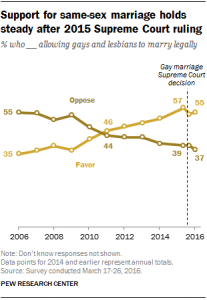As edits have been made and we prepare for the final presentation of our website tomorrow, we can reflect on our goals laid out for the project earlier in the semester. Starting with the mission statement, we hoped “to demonstrate all sides of the case” before knowing exactly what perspectives we would be able to secure or even who challenged the book. Fortunately, I feel we reached this goal through interviews with Carly Maldonado, Trish Warren, and Alex Sanchez, and while Rev. Morse was not willing to interview, I feel we fairly represented his perspective through the church in Rochester he worked for and his Facebook page. Through all of these voices, and some of the information shared in our historical context page. I think the complexity of the case is well illustrated. In terms of our use of materials, expectations matched reality with the use of WordPress, Youtube, Coggle, Googledocs, Readability, and online newspaper resources, though we ended up not needing to use Audacity to edit the Trish Warren interview because it was clear and complete as initially recorded. Looking at the division of labor, while some of our expected project components proved unnecessary and others were added in, we closely followed our plan for the most part. Both Liz and I wrote content for the site, found images and edited for accuracy and appearance. Liz handled the unforeseen task of compiling and transcribing our newspaper articles so I took care of all of the historical context to help maintain a fair balance. We also decided against incorporating a specific cast of characters page because the various perspectives are clearly laid out on the side of the website, and an extra page seemed redundant. Another challenge we ran into was the debate over interviewing Devin Flaherty as initially established in the contract’s division of labor and milestones. We thought Devin might be a useful perspective because she challenged Trish Warren years later on the decision to omit Perks of Being a Wallflower from the school library. However, we eventually concluded that spending time and space detailing that conflict, we would be better off using it as just brief context to the Rainbow Boys case and not focusing on Trish’s comments on the subject or choosing to interview Devin separately. Knowing we already had a former Webster Thomas student passionate about uncensored access to books in Carly Maldonado made the decision to omit an interview with Devin more reasonable. Our interviews stayed on schedule as well as they could considering the need to be flexible with our interviewees, and while some of our proposed dates for having content uploaded were missed due to various “life happens” moments, we caught up before the deadline for the rough draft on April 9th.
Overall, I thought having the project contract was most useful for establishing a division of labor that could keep Liz and I accountable and working equally to ensure the success of the project. We made adjustments as needed, trading off one task for another based on the contract which allowed me to always feel like Liz and I were contributing equally which I think is really valuable in such an extensive partner project. Additionally, the feedback from from our peers and Professors Dierking and Hajo kept us on track and helped us make changes as needed to end up with a project that I’m proud of and that also fits the goals we laid out for ourselves in the contract.






